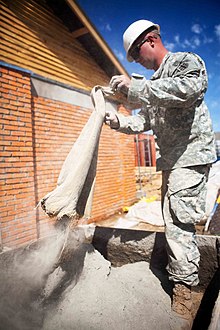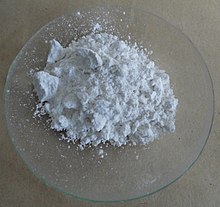
A | B | C | D | E | F | G | H | CH | I | J | K | L | M | N | O | P | Q | R | S | T | U | V | W | X | Y | Z | 0 | 1 | 2 | 3 | 4 | 5 | 6 | 7 | 8 | 9


A cement is a binder, a chemical substance used for construction that sets, hardens, and adheres to other materials to bind them together. Cement is seldom used on its own, but rather to bind sand and gravel (aggregate) together. Cement mixed with fine aggregate produces mortar for masonry, or with sand and gravel, produces concrete. Concrete is the most widely used material in existence and is behind only water as the planet's most-consumed resource.[2]
Cements used in construction are usually inorganic, often lime or calcium silicate based, which can be characterized as hydraulic or the less common non-hydraulic, depending on the ability of the cement to set in the presence of water (see hydraulic and non-hydraulic lime plaster).
Hydraulic cements (e.g., Portland cement) set and become adhesive through a chemical reaction between the dry ingredients and water. The chemical reaction results in mineral hydrates that are not very water-soluble. This allows setting in wet conditions or under water and further protects the hardened material from chemical attack. The chemical process for hydraulic cement was found by ancient Romans who used volcanic ash (pozzolana) with added lime (calcium oxide).
Non-hydraulic cement (less common) does not set in wet conditions or under water. Rather, it sets as it dries and reacts with carbon dioxide in the air. It is resistant to attack by chemicals after setting.
The word "cement" can be traced back to the Ancient Roman term opus caementicium, used to describe masonry resembling modern concrete that was made from crushed rock with burnt lime as binder. The volcanic ash and pulverized brick supplements that were added to the burnt lime, to obtain a hydraulic binder, were later referred to as cementum, cimentum, cäment, and cement. In modern times, organic polymers are sometimes used as cements in concrete.
World production of cement is about 4.4 billion tonnes per year (2021, estimation),[3][4] of which about half is made in China, followed by India and Vietnam.[3][5]
The cement production process is responsible for nearly 8% (2018) of global CO2 emissions,[4] which includes heating raw materials in a cement kiln by fuel combustion and resulting release of CO2 stored in the calcium carbonate (calcination process). Its hydrated products, such as concrete, gradually reabsorb substantial amounts of atmospheric CO2 (carbonation process) compensating near 30% of initial CO2 emissions, as estimations suggest.[6]
Chemistry
Cement materials can be classified into two distinct categories: hydraulic cements and non-hydraulic cements according to their respective setting and hardening mechanisms. Hydraulic cement setting and hardening involves hydration reactions and therefore requires water, while non-hydraulic cements only react with a gas and can directly set under air.
Hydraulic cement

By far the most common type of cement is hydraulic cement, which hardens by hydration of the clinker minerals when water is added. Hydraulic cements (such as Portland cement) are made of a mixture of silicates and oxides, the four main mineral phases of the clinker, abbreviated in the cement chemist notation, being:
- C3S: alite (3CaO·SiO2);
- C2S: belite (2CaO·SiO2);
- C3A: tricalcium aluminate (3CaO·Al2O3) (historically, and still occasionally, called celite);
- C4AF: brownmillerite (4CaO·Al2O3·Fe2O3).
The silicates are responsible for the cement's mechanical properties — the tricalcium aluminate and brownmillerite are essential for the formation of the liquid phase during the sintering (firing) process of clinker at high temperature in the kiln. The chemistry of these reactions is not completely clear and is still the object of research.[7]
First, the limestone (calcium carbonate) is burned to remove its carbon, producing lime (calcium oxide) in what is known as a calcination reaction. This single chemical reaction is a major emitter of global carbon dioxide emissions.[8]
The lime reacts with silicon dioxide to produce dicalcium silicate and tricalcium silicate.
The lime also reacts with aluminium oxide to form tricalcium aluminate.
In the last step, calcium oxide, aluminium oxide, and ferric oxide react together to form brownmillerite.
Non-hydraulic cement

A less common form of cement is non-hydraulic cement, such as slaked lime (calcium oxide mixed with water), which hardens by carbonation in contact with carbon dioxide, which is present in the air (~ 412 vol. ppm ≃ 0.04 vol. %). First calcium oxide (lime) is produced from calcium carbonate (limestone or chalk) by calcination at temperatures above 825 °C (1,517 °F) for about 10 hours at atmospheric pressure:
The calcium oxide is then spent (slaked) by mixing it with water to make slaked lime (calcium hydroxide):
Once the excess water is completely evaporated (this process is technically called setting), the carbonation starts:
This reaction is slow, because the partial pressure of carbon dioxide in the air is low (~ 0.4 millibar). The carbonation reaction requires that the dry cement be exposed to air, so the slaked lime is a non-hydraulic cement and cannot be used under water. This process is called the lime cycle.
History
Perhaps the earliest known occurrence of cement is from twelve million years ago. A deposit of cement was formed after an occurrence of oil shale located adjacent to a bed of limestone burned by natural causes. These ancient deposits were investigated in the 1960s and 1970s.[9]
Alternatives to cement used in antiquity
Cement, chemically speaking, is a product that includes lime as the primary binding ingredient, but is far from the first material used for cementation. The Babylonians and Assyrians used bitumen to bind together burnt brick or alabaster slabs. In Ancient Egypt, stone blocks were cemented together with a mortar made of sand and roughly burnt gypsum (CaSO4 · 2H2O), which is Plaster of Paris, which often contained calcium carbonate (CaCO3),[10]
Ancient Greece and Rome
Lime (calcium oxide) was used on Crete and by the Ancient Greeks. There is evidence that the Minoans of Crete used crushed potsherds as an artificial pozzolan for hydraulic cement.[10] Nobody knows who first discovered that a combination of hydrated non-hydraulic lime and a pozzolan produces a hydraulic mixture (see also: Pozzolanic reaction), but such concrete was used by the Greeks, specifically the Ancient Macedonians,[11][12] and three centuries later on a large scale by Roman engineers.[13][14][15]
There is... a kind of powder which from natural causes produces astonishing results. It is found in the neighborhood of Baiae and in the country belonging to the towns round about Mount Vesuvius. This substance when mixed with lime and rubble not only lends strength to buildings of other kinds but even when piers of it are constructed in the sea, they set hard underwater.
— Marcus Vitruvius Pollio, Liber II, De Architectura, Chapter VI "Pozzolana" Sec. 1
The Greeks used volcanic tuff from the island of Thera as their pozzolan and the Romans used crushed volcanic ash (activated aluminium silicates) with lime. This mixture could set under water, increasing its resistance to corrosion like rust.[16] The material was called pozzolana from the town of Pozzuoli, west of Naples where volcanic ash was extracted.[17] In the absence of pozzolanic ash, the Romans used powdered brick or pottery as a substitute and they may have used crushed tiles for this purpose before discovering natural sources near Rome.[10] The huge dome of the Pantheon in Rome and the massive Baths of Caracalla are examples of ancient structures made from these concretes, many of which still stand.[18][2] The vast system of Roman aqueducts also made extensive use of hydraulic cement.[19] Roman concrete was rarely used on the outside of buildings. The normal technique was to use brick facing material as the formwork for an infill of mortar mixed with an aggregate of broken pieces of stone, brick, potsherds, recycled chunks of concrete, or other building rubble.[20]
Mesoamerica
Lightweight concrete was designed and used for the construction of structural elements by the pre-Columbian builders who lived in a very advanced civilisation in El Tajin near Mexico City, in Mexico. A detailed study of the composition of the aggregate and binder show that the aggregate was pumice and the binder was a pozzolanic cement made with volcanic ash and lime.[21]
Middle Ages
Any preservation of this knowledge in literature from the Middle Ages is unknown, but medieval masons and some military engineers actively used hydraulic cement in structures such as canals, fortresses, harbors, and shipbuilding facilities.[22][23] A mixture of lime mortar and aggregate with brick or stone facing material was used in the Eastern Roman Empire as well as in the West into the Gothic period. The German Rhineland continued to use hydraulic mortar throughout the Middle Ages, having local pozzolana deposits called trass.[20]
16th century
Tabby is a building material made from oyster shell lime, sand, and whole oyster shells to form a concrete. The Spanish introduced it to the Americas in the sixteenth century.[24]
18th century
The technical knowledge for making hydraulic cement was formalized by French and British engineers in the 18th century.[22]
John Smeaton made an important contribution to the development of cements while planning the construction of the third Eddystone Lighthouse (1755–59) in the English Channel now known as Smeaton's Tower. He needed a hydraulic mortar that would set and develop some strength in the twelve-hour period between successive high tides. He performed experiments with combinations of different limestones and additives including trass and pozzolanas[10] and did exhaustive market research on the available hydraulic limes, visiting their production sites, and noted that the "hydraulicity" of the lime was directly related to the clay content of the limestone used to make it. Smeaton was a civil engineer by profession, and took the idea no further.
In the South Atlantic seaboard of the United States, tabby relying on the oyster-shell middens of earlier Native American populations was used in house construction from the 1730s to the 1860s.[24]
Zdroj:https://en.wikipedia.org?pojem=Cement_industry
Text je dostupný za podmienok Creative Commons Attribution/Share-Alike License 3.0 Unported; prípadne za ďalších podmienok. Podrobnejšie informácie nájdete na stránke Podmienky použitia.
Antropológia
Aplikované vedy
Bibliometria
Dejiny vedy
Encyklopédie
Filozofia vedy
Forenzné vedy
Humanitné vedy
Knižničná veda
Kryogenika
Kryptológia
Kulturológia
Literárna veda
Medzidisciplinárne oblasti
Metódy kvantitatívnej analýzy
Metavedy
Metodika
Text je dostupný za podmienok Creative
Commons Attribution/Share-Alike License 3.0 Unported; prípadne za ďalších
podmienok.
Podrobnejšie informácie nájdete na stránke Podmienky
použitia.
www.astronomia.sk | www.biologia.sk | www.botanika.sk | www.dejiny.sk | www.economy.sk | www.elektrotechnika.sk | www.estetika.sk | www.farmakologia.sk | www.filozofia.sk | Fyzika | www.futurologia.sk | www.genetika.sk | www.chemia.sk | www.lingvistika.sk | www.politologia.sk | www.psychologia.sk | www.sexuologia.sk | www.sociologia.sk | www.veda.sk I www.zoologia.sk







